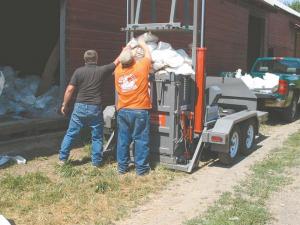Farm Plastic Collection Success
 ✖  |
A good percentage of bale wrap and greenhouse plastic on New York farms is being turned into trash bags and plastic lumber, thanks to Cornell University’s Recycling Agricultural Plastics Program (RAPP). The program promotes on-farm baling to make recycling easier than disposal.
“In the first 3 to 4 years we collected and shipped about 1.25 million lbs. of plastic. In the past 6 months alone, we’ve shipped about 650,000 lbs.,” says Nate Leonard, field coordinator for RAPP.
In 2010 New York funded the program to reduce burning and landfilling of waste plastics. A year earlier, a statewide ban had been placed on burning ag plastics. At the time, an estimated 50 percent of all ag plastics were burned on the farm. There were almost no markets for ag plastics and no market at all for the plastic film used on greenhouses and for mulch.
RAPP attacked the problem at the demand end first, working with recycling companies to find new markets. With markets identified, they placed mobile balers around the state with Soil and Water Conservation Districts (SWCD) and worked with local extension offices to help farmers understand what level of cleanliness was needed to recycle ag plastics.
“Our collection rate is going up dramatically,” says Leonard. “If you don’t make it too difficult for farmers to participate, a large percentage want to recycle and are willing to transfer plastic bales to local or regional recycling centers. In one county with large dairy operations, we went from no collection to more than 40 percent.”
Farmers are asked to think about recycling as they remove the plastic from bales, silage, or mulched crops, cutting it into pieces small enough for residue to be shaken off. One farmer built homemade bins for collecting bale wrap as bales are fed out.
“It’s easier to put several pallets together and build a pile on them than to stuff dirty plastic into a dumpster,” says Leonard. “We can tolerate some moisture. The big concern is gravel and stone grit, which can damage recycling equipment.”
Once farmers have enough plastic to make a 1,000-lb. bale, they contact the local extension or SWCD. They are then added to the list for the next round of on-farm baling.
The farm provides labor to help the operator compact the plastic into 40-in. cubes and then stores the bales for future collection.
An early use for bale wrap was plastic sidewalk pavers. Another company is making 4 by 8-ft. sheets of plastic plywood. Still another makes plastic trash bags.
Contact: FARM SHOW Followup, Recycling Agricultural Plastics Program, Cornell Waste Management Institute, 817 Bradfield Hall, Cornell University, Ithaca, N.Y. 14853 (ph 607 255-1187; agplasticsrecycling@cornell.edu; www.recycleagplastics.css.cals.cornell.edu).

Click here to download page story appeared in.
Click here to read entire issue
Farm Plastic Collection Success MISCELLANEOUS EQUIPMENT Miscellaneous A good percentage of bale wrap and greenhouse plastic on New York farms is being turned into trash bags and plastic lumber thanks to Cornell University’s Recycling Agricultural Plastics Program RAPP The program promotes on-farm baling to make recycling easier than disposal “In the first 3 to 4 years we collected and shipped about 1 25 million lbs of plastic In the past 6 months alone we’ve shipped about 650 000 lbs ” says Nate Leonard field coordinator for RAPP In 2010 New York funded the program to reduce burning and landfilling of waste plastics A year earlier a statewide ban had been placed on burning ag plastics At the time an estimated 50 percent of all ag plastics were burned on the farm There were almost no markets for ag plastics and no market at all for the plastic film used on greenhouses and for mulch RAPP attacked the problem at the demand end first working with recycling companies to find new markets With markets identified they placed mobile balers around the state with Soil and Water Conservation Districts SWCD and worked with local extension offices to help farmers understand what level of cleanliness was needed to recycle ag plastics “Our collection rate is going up dramatically ” says Leonard “If you don’t make it too difficult for farmers to participate a large percentage want to recycle and are willing to transfer plastic bales to local or regional recycling centers In one county with large dairy operations we went from no collection to more than 40 percent ” Farmers are asked to think about recycling as they remove the plastic from bales silage or mulched crops cutting it into pieces small enough for residue to be shaken off One farmer built homemade bins for collecting bale wrap as bales are fed out “It’s easier to put several pallets together and build a pile on them than to stuff dirty plastic into a dumpster ” says Leonard “We can tolerate some moisture The big concern is gravel and stone grit which can damage recycling equipment ” Once farmers have enough plastic to make a 1 000-lb bale they contact the local extension or SWCD They are then added to the list for the next round of on-farm baling The farm provides labor to help the operator compact the plastic into 40-in cubes and then stores the bales for future collection An early use for bale wrap was plastic sidewalk pavers Another company is making 4 by 8-ft sheets of plastic plywood Still another makes plastic trash bags Contact: FARM SHOW Followup Recycling Agricultural Plastics Program Cornell Waste Management Institute 817 Bradfield Hall Cornell University Ithaca N Y 14853 ph 607 255-1187; agplasticsrecycling@cornell edu; www recycleagplastics css cals cornell edu
To read the rest of this story, download this issue below or click
here to register with your account number.







